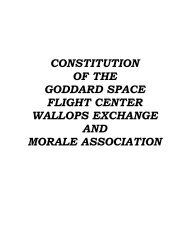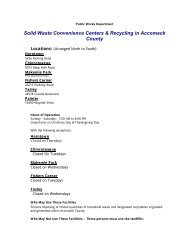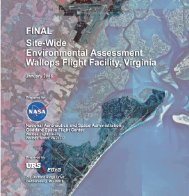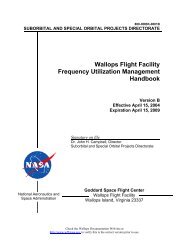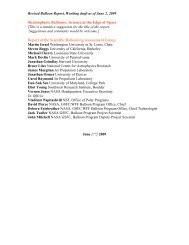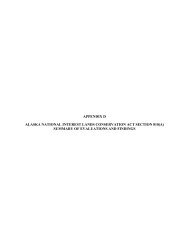Alternative Energy Draft EA - NASA Visitor Center at Wallops Flight ...
Alternative Energy Draft EA - NASA Visitor Center at Wallops Flight ...
Alternative Energy Draft EA - NASA Visitor Center at Wallops Flight ...
You also want an ePaper? Increase the reach of your titles
YUMPU automatically turns print PDFs into web optimized ePapers that Google loves.
4.2.5 Noise<br />
No Action <strong>Altern<strong>at</strong>ive</strong><br />
Environmental Consequences<br />
Under the No Action <strong>Altern<strong>at</strong>ive</strong>, implement<strong>at</strong>ion of the <strong>Altern<strong>at</strong>ive</strong> <strong>Energy</strong> Project would not<br />
occur; therefore, there would be no additional increase in noise levels <strong>at</strong> WFF so no new impacts<br />
on humans or wildlife from noise would occur.<br />
Proposed Action<br />
Construction activities have the potential to gener<strong>at</strong>e temporary increases in noise levels from<br />
heavy equipment oper<strong>at</strong>ions such as grading, filling, pile driving, and wind turbine construction.<br />
<strong>NASA</strong> would comply with local noise ordinances and St<strong>at</strong>e and Federal standards and guidelines<br />
for potential impacts on humans caused by construction activities.<br />
OSHA limits noise exposure for workers to 115 dBA for a period of no longer than 15 minutes in<br />
an 8-hour work shift and to 90 dBA for an entire 8-hour shift. Workers near activities producing<br />
unsafe noise levels, both during construction and during maintenance or repair oper<strong>at</strong>ions after<br />
the turbines are oper<strong>at</strong>ional, would be required to wear hearing protection equipment. Therefore,<br />
impacts on the occup<strong>at</strong>ional health of construction workers as a result of construction noise are<br />
not expected.<br />
Modern wind turbines are generally quiet in oper<strong>at</strong>ion, and compared to the noise of road traffic,<br />
trains, aircraft and construction activities, to name but a few, the noise from wind turbines is very<br />
low (The Working Group on Wind Turbine Noise, 1996). Outside of homes th<strong>at</strong> are <strong>at</strong> least 300<br />
meters (980 feet) away from large wind turbines, the sound of a wind turbine gener<strong>at</strong>ing<br />
electricity is likely to be about the same level as noise from a flowing stream about 50 to 100<br />
meters (160 to 330 feet) away or the noise of leaves rustling in a gentle breeze. The noise level<br />
from a single wind turbine cre<strong>at</strong>es a sound pressure level of 50 to 60 dBA <strong>at</strong> a distance of 40<br />
meters (131 feet) from the turbine, which is about the same level as convers<strong>at</strong>ional speech. At a<br />
house 500 meters (1,640 feet) away, the equivalent sound pressure level would be 25 to 35 dBA<br />
when the wind is blowing from the turbine towards the house (The Working Group on Wind<br />
Turbine Noise, 1996). Additionally, the proposed 2.0 MW wind turbine would use a gener<strong>at</strong>or<br />
and gearbox with elements th<strong>at</strong> minimize noise.<br />
The closest facility occupied by personnel to the utility-scale wind turbines would be the U.S.<br />
Navy V-10/V-20 Complex, which is approxim<strong>at</strong>ely 120 meters (400 feet) east of the proposed<br />
northern wind turbine loc<strong>at</strong>ion. The two known loc<strong>at</strong>ions of the residential-scale wind turbines<br />
are proposed <strong>at</strong> the WFF <strong>Visitor</strong> <strong>Center</strong> and the Mainland guard st<strong>at</strong>ion. Employees and visitors<br />
to these facilities would hear the turbines while they were outside of the buildings, but they<br />
would not hear the turbines from inside the buildings. The noise from the residential-scale<br />
turbines, on windy days, may sound like a faint “whoosh.” However, most of the time the<br />
residential-scale turbines would not be heard by people standing outside of the <strong>Visitor</strong> <strong>Center</strong> or<br />
Mainland guard st<strong>at</strong>ion, so the impacts on those employees and visitors would be minor. Neither<br />
the public nor employees and visitors to WFF outside of <strong>Wallops</strong> Island would be able to hear<br />
the utility-scale wind turbines; therefore, there would be no impacts on either of these two groups<br />
from oper<strong>at</strong>ion of the wind turbines. Oper<strong>at</strong>ion of two utility-scale and the residential-scale wind<br />
turbines would result in highly localized, long-term, minor impacts on the surrounding<br />
environment from noise.<br />
106



